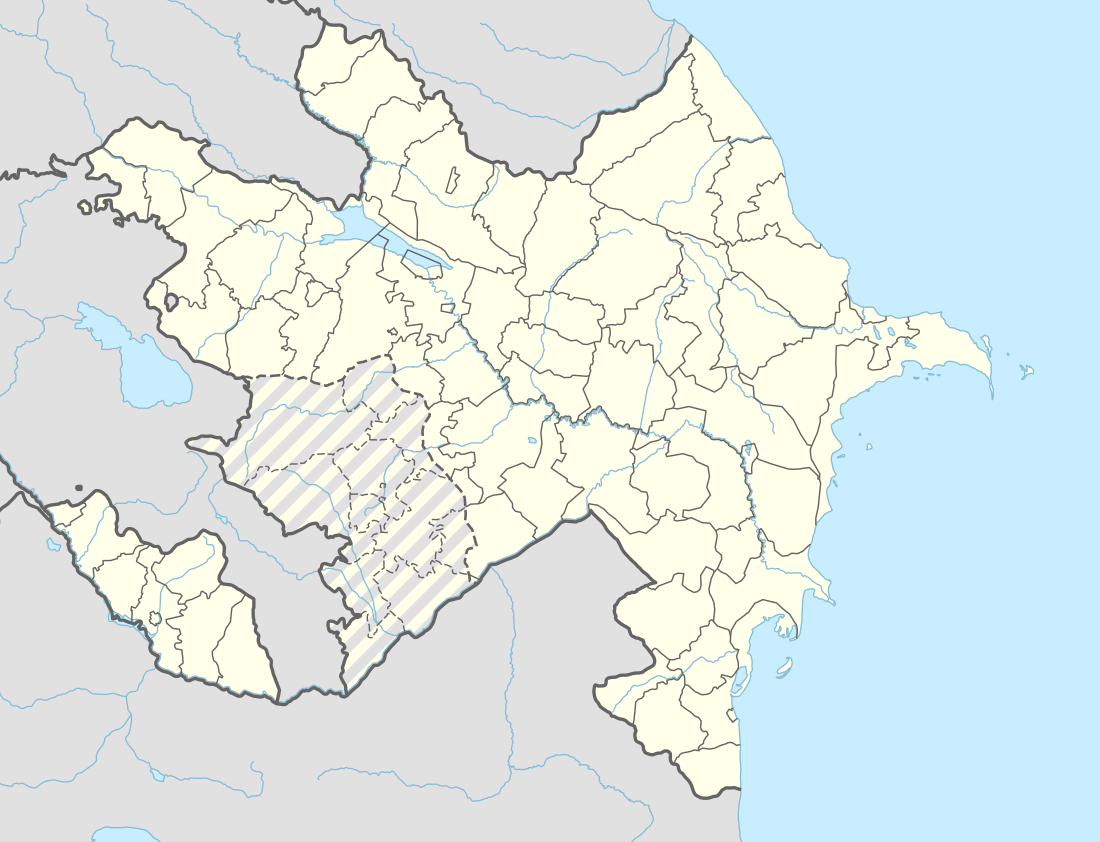Gülüstan, Goranboy
Gülüstan (Armenian: Գյուլիստան, Gyulistan) is a village in the Goranboy District of Azerbaijan, which is part of the municipality of Buzluq.[1] Gülüstan (گلستان Gulistan/Golestan) is a Persian word and means "The flower Garden".
Gülüstan Գյուլիստան (Gyulistan) Gülüstan | |
|---|---|
Gülüstan | |
 Gülüstan | |
| Coordinates: 40°21′30″N 46°34′43″E | |
| Country | Disputed between |
| Rayon Province | Goranboy Shahumyan |
| Municipality | Buzluq |
| Time zone | UTC+4 (AZT) |
| • Summer (DST) | UTC+5 (AZT) |
Between the 16th and the 18th century, the Fortress of Gulistan (3 km from the village) was seat of the Principality of Gulistan under the leadership of the Armenian Melik Beglarian family, one of the Five Melikdoms of Karabakh.[2][3][4]
Gülüstan has a historical significance for being the village where the Treaty of Gulistan was signed between the Russian Empire and Qajar Iran on 12 October 1813, concluding the nine-year-long Russo-Persian War. According to the agreement, Qajar Iran was forced to recognize Russian rule over territories north of Arax river (i.e. present-day territory of Dagestan, Georgia, Northern Armenia and most of present Azerbaijan without Talysh) with the exception of the Khanates of Erivan and Nakhchivan.[5]
In the Soviet times, the village was part of the Shahumyan Region, a majority-Armenian administrative unit outside the Nagorno-Karabakh Autonomous Oblast. Before 1991, the village was inhabited by ethnic Armenians who fled in the wake of Operation Goranboy.[6] The Shahumian Region was then incorporated into the Goranboy District. Currently, Gülüstan is located in close proximity to the contact line between the Nagorno-Karabakh Defense Army (which claims the village) and the army of Azerbaijan.
On 3 March 1992 an Armenian transport helicopter Mi-26 carrying around 50 women and children from Gülüstan on board was shot down with a MANPADS rocket from Azerbaijan-controlled territory, and 16 people were killed.[7][8]
Notable natives of the village are Garegin Balayan (1912–1943, hero of the Soviet Union)[9] and Shahen Meghrian (1952–1993, NKR military commander of Shahumyan region).[10]
See also
References
- "Bələdiyyə İnformasiya Sistemi" (in Azerbaijani). Archived from the original on September 24, 2008.
- Encyclopaedia Britannica: Armenia:"In mountainous Karabakh a group of five Armenian maliks (princes) succeeded in conserving their autonomy and maintained a short period of independence (1722-30) during the struggle between Persia and Turkey at the beginning of the 18th century; despite the heroic resistance of the Armenian leader David Beg, the Turks occupied the region but were driven out by the Persians under the general Nādr Qolī Beg (from 1736-47, Nādir Shah) in 1735."
- Encyclopaedia of Islam. — Leiden: BRILL, 1986. — vol. 1. — p. 639-640.
- Րաֆֆի (Հակոբ Մելիք-Հակոբյան). Խամսայի մելիքութիւնները: Ղարաբաղի աստղագէտը: Գաղտնիքն Ղարաբաղի, Վիեննա, 1906. [Raffi (Hakob Melik-Hakobyan). The History of Karabagh's Meliks, Vienna, 1906, in Armenian. Another edition is «Խամսայի մելիքությունները», Երկերի ժողովածու, Երևան, 1964. Collection of Yerkrapah, Yerevan, 1964.]
- Вячеслав Румянцев (Редактор/ed.). Гюлистанский мирный договор, 1813 г. ХРОНОС, 20 January 2000.
- http://census.stat-nkr.am/nkr/1-1.pdf
- Большая авиационная энциклопедия «Уголок неба»
- "Михаил Жирохов «Авиация в Нагорном Карабахе»". Archived from the original on 2010-04-28. Retrieved 2018-02-04.
- "Навечно в строю": Гарегин Шегиевич Балаян
- Shahen Meghrian // Aravot Daily, 17.04.2008
.svg.png)